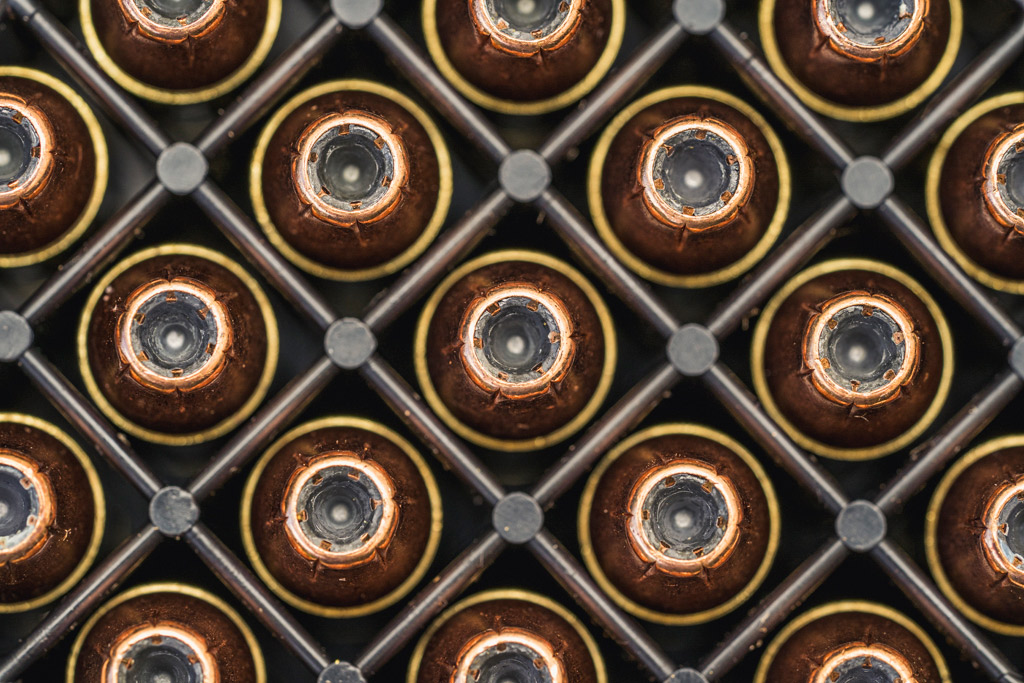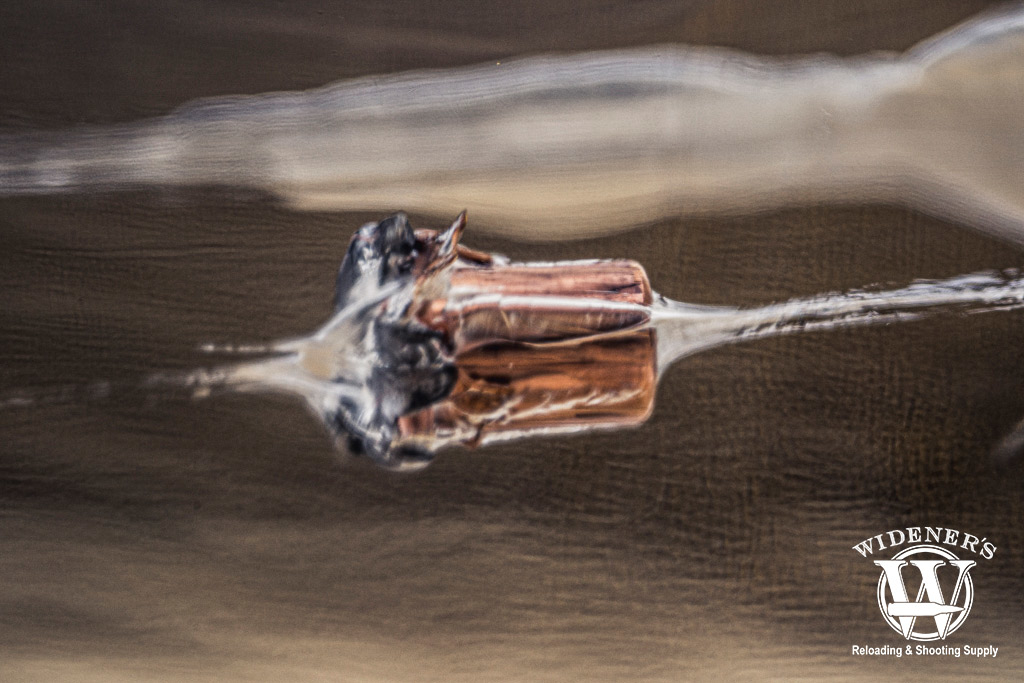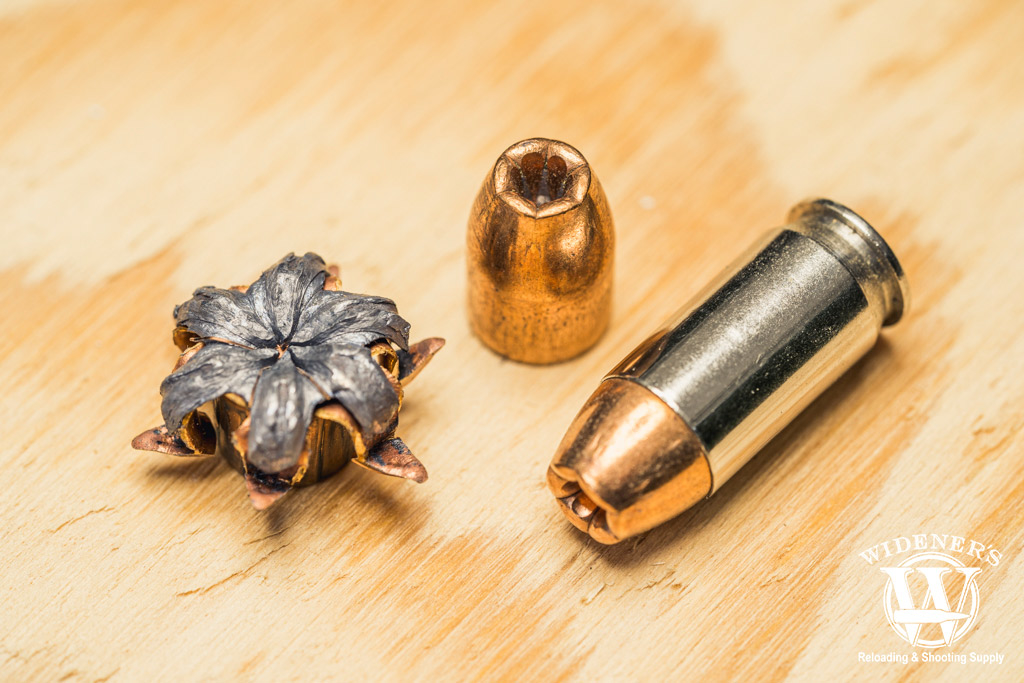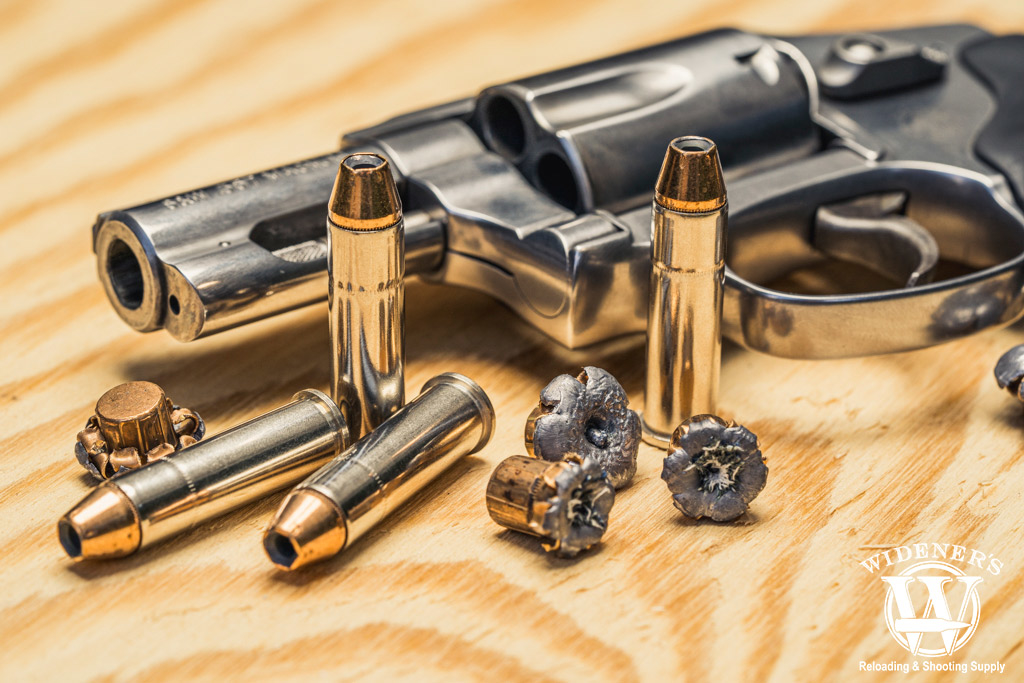

By Guy J. Sagi
The science and technology hidden in today’s jacketed hollow point (JHP) bullets can be lifesaving in a criminal attack, making them the ideal choice for self-defense—particularly in handguns. The design is simple in principle, but modern engineering has packed better-than-ever fight-stopping performance into these projectiles.
JHP Bullets Explained

The FBI protocol for testing JHP bullets includes firing them through barriers into ballistic gelatin.
This alchemy is no urban myth, either. Manufacturers conduct exhaustive testing in which they launch hundreds of bullets into ballistic gelatin that emulates muscle tissue in humans. Measurements that follow include length of travel until the projectile comes to rest, final weight, diameter after it has assumed that familiar “mushroom” shape and more.
Variables introduced during these test sessions also often reflect real-life scenarios. Clothing placed in front of the ballistic gel, for example, helps determine if clogging compromises the JHP’s terminal performance. When some hollow points fill with material, they can act like an FMJ. They wind up completely passing through the target with minimal energy transfer. That reduces the odds of the shot stopping a criminal attack. Also, the bullet remains in flight until it either runs out of energy or, worse yet, strikes something unintended.
The FBI has established rigorous testing procedures for the bullets and cartridges used by law enforcement. Barriers used to test these cartridges include fabric garments, metal, windows and other materials. In the tests, the bullets fired must still meet minimum expansion and weight-retention standards, without overpenetration.
It’s a lofty task and, obviously, and not a simple matter of wrapping a hunk of lead in another metal and drilling a hole. To complicate things further for manufacturers, more than 16 million people have permits to carry concealed today. Most of them rely on smaller handguns and the slight reduction in muzzle velocity caused by the shorter barrels. Cutting-edge designs and materials eloquently address that problem, although there’s some irony in the fact that the need for speed is what created hollow points in the first place.
JHP History

The petals of the JHP bullet peel back to increase the wound channel size once they make contact with a dense object.
The balls of lead used for projectiles in early firearms performed adequately on impact but did not always provide reliable results. As gun designs improved, firearms added rifling, more powder and tested the limits of a bullet’s effective range. William Greener came up with a concept in 1855 that James Purdey made famous the next year. His introduction of the high-velocity Express rifle—meant more speed, a flatter trajectory and greater knockdown power.
Part of the secret to the faster bullets was a hollow cavity, usually in its nose, to lighten the load. It didn’t take long for hunters to note the improved expansion and performance on thin-skinned animals. Bullet jackets remained, however, to manage pure lead’s unpredictable performance downrange at high velocity. This also proved to minimize its notorious barrel fouling which could decrease accuracy and shorten the life of the firearm.
Dum Dum Link
When the British crown took a dim view of an insurrection in India in the 1890s, the response was a military one. The British Army brought .303-caliber rifles to deal with the threat of rebels disrupting the peace. Unfortunately, the issued FMJ ammo proved extremely poor at slowing attackers.
In1896 Lt.-Col. Neville Sneyd Bertie-Clay discovered a solution while he was working for the British Indian Army at the Dum Dum Arsenal in Bengal. He exposed the lead on the FMJ’s tip. The terminal performance proved both reliable in firearms and capable of stopping revolutionaries. The expanding bullets quickly earned the dum dum nickname.
Improved designs followed, including filed down tips, and a hollow-point version. A New York Times article in 1892 provides something of an argument that the design was already in the works, crediting a wondrous new “mushroom bullet” to Britain’s Major General William Tweedie.
The performance was so undeniable that in 1899 representatives from 24 countries convened in the Netherlands for the First Hague Conference. Among the Laws of War, the group formulated is this declaration:
“The Contracting Parties agree to abstain from the use of bullets which expand or flatten easily in the human body, such as bullets with a hard envelope which does not entirely cover the core, or is pierced with incisions.” The United States did not ratify the section.
There’s no doubt its effectiveness in today’s self-defense handgun ammunition would stagger Bertie-Clay. The reliable expansion, from relatively low-velocity handgun bullets, is nothing short of a modern marvel.
Modern JHP Ammo

(On the left): An expanded JHP bullet (Middle): A JHP bullet removed from the casing (On the right): Complete JHP ammo with the bullet, casing, gunpowder, and primer.
A sizeable, metal-free cavity up front remains the primary principle of the JHP bullet. However, improved metallurgy and even polymers are now an integral part of many efficient JHP designs. Visually, you can quickly tell the difference between JHP and FMJ ammo simply by looking at the tip of the bullet. Reduction of lead fouling is one of the primary advantages of the rival FMJ jacket. This ball-shaped round often features a slight lube or polish to improve cycling in semi-auto firearms.
Most of today’s JHP versions also feature jackets bonded to the lead to prevent peeling/failing on impact. Tapered jackets control the rate of expansion and often initiate early mushrooming on impact. Some have an interior partition to halt the process of expanding the entire projectile, which can compromise terminal performance. Others feature weak points or fluting to promote petal peeling along prescribed longitudinal lines.
Modern polymers have even entered the mix. Place the right mix into the hollow point, and the bullet passes through intermediate barriers without clogging. Even with the polymer plug in place, the bullet properly expands with hydraulic pressure—like ballistic gelatin or armed home invaders. Filling that bullet’s gaping hole up front doesn’t hurt semi-automatic feeding, either.
Testing JHP Ammo
Technology may make things seem more complicated, but manufacturers are more tedious in testing than ever before. They invest thousands of manpower hours at the bench, and in the lab to ensure the JHP you take home will perform from that cartridge, and usually meet the FBI’s stringent protocol. You don’t need to take their word for it, either. Dozens of gun writers cook that nasty-smelling ballistic gel every month to confirm the results.
Regardless, you should never trust your life to any self-defense ammo you have not tested thoroughly in your gun. Odds are good it will perform flawlessly, but expect a slight shift in point of impact, due mainly to the different bullet weight and profile.
JHP Self-Defense Solution

JHP ammo can be carried in a variety of weapons including revolvers, striker-fired semi-automatic handguns and carbine style rifles.
Today it’s hard to go wrong, regardless of the JHP bullet and load you select. Manufacturers are upping their game by bringing reliable JHP self-defense options to the market. They don’t slip through walls with the aplomb of less-expensive FMJs, but they deliver fight-stopping power to law-abiding citizens when they need it.


